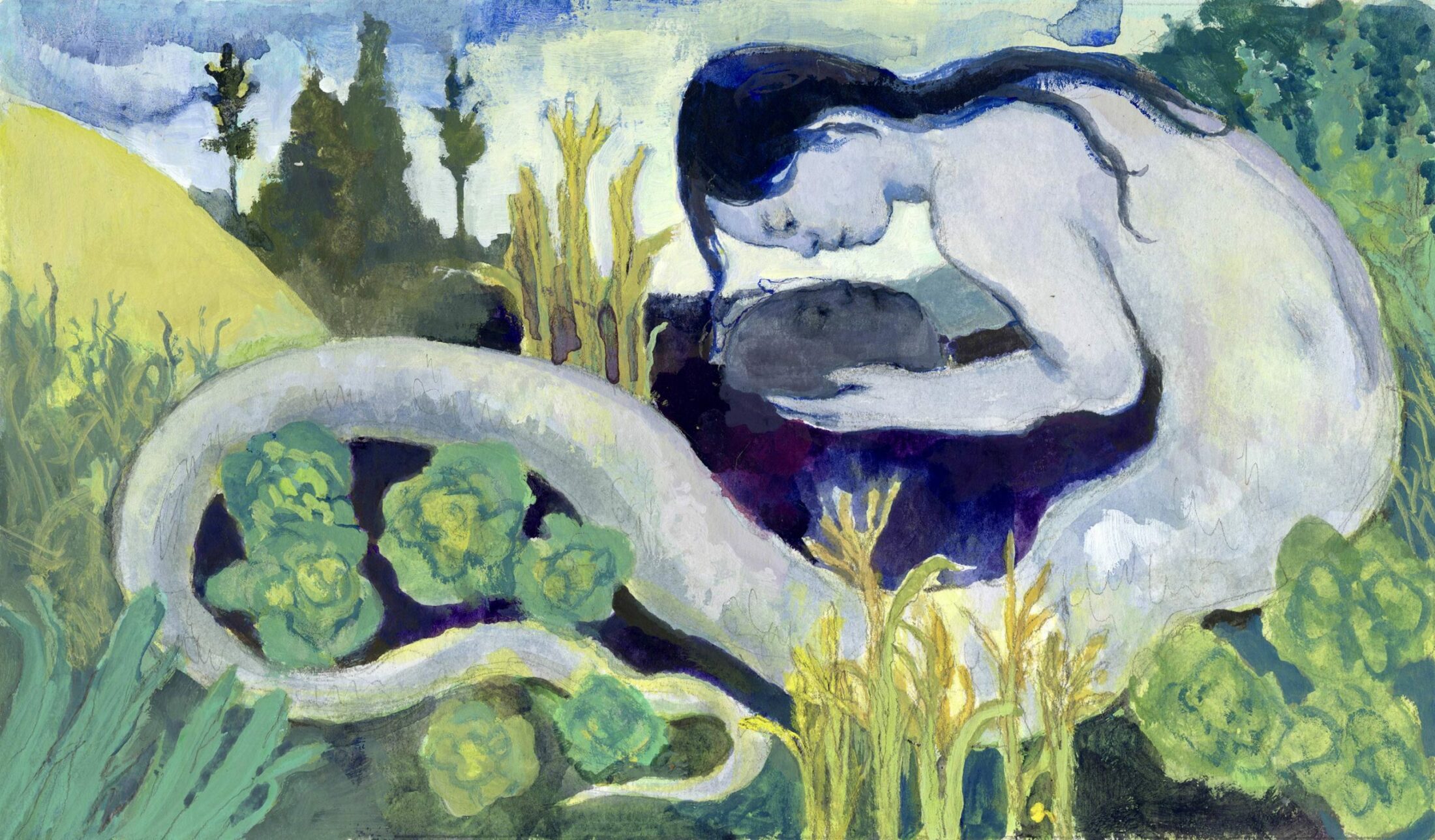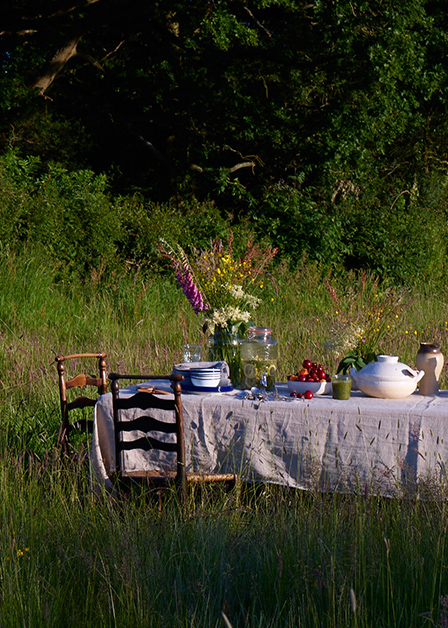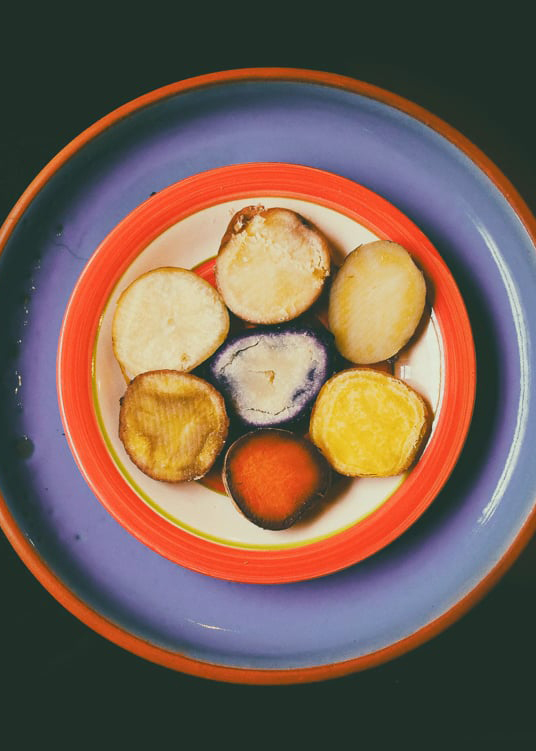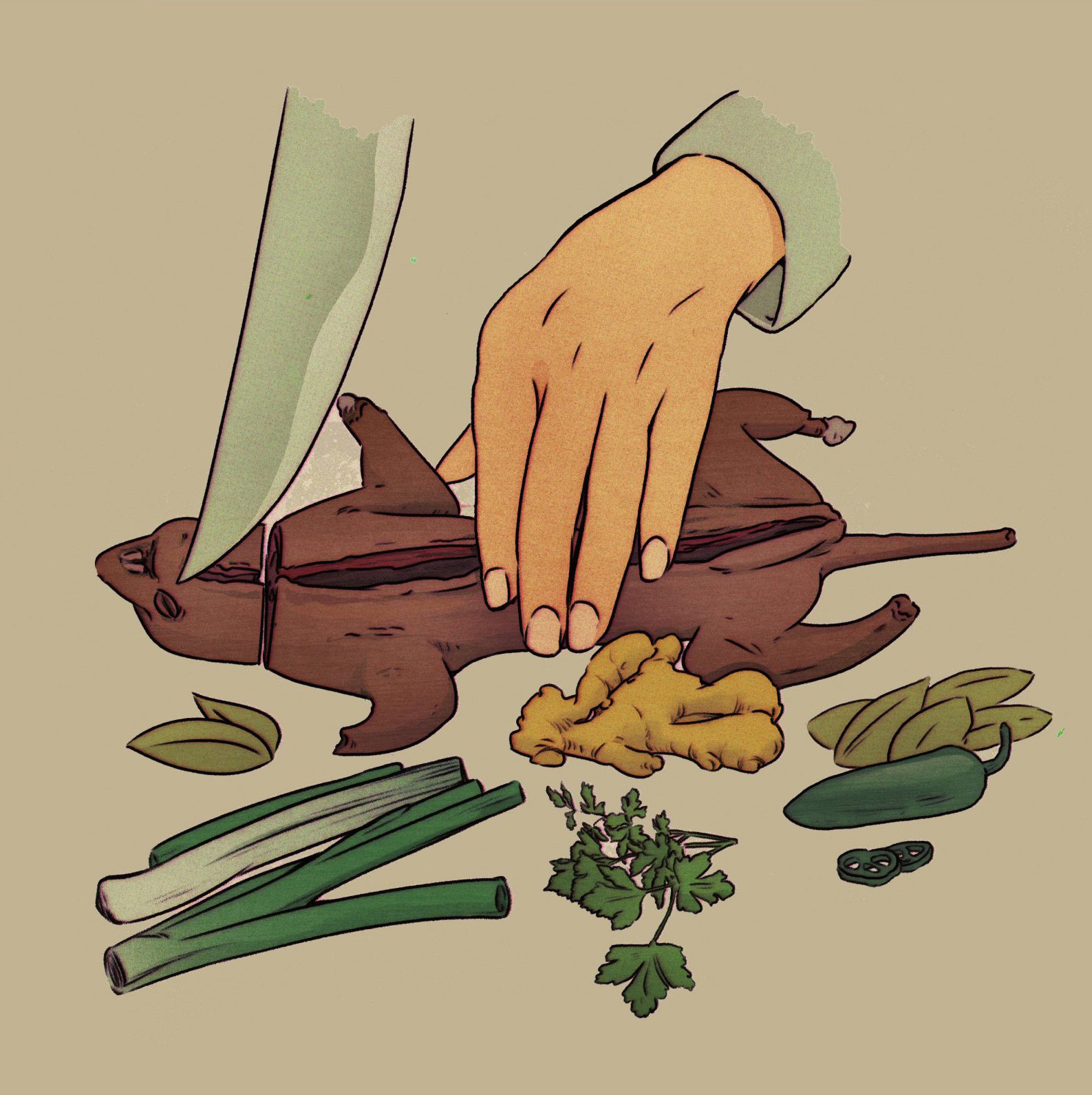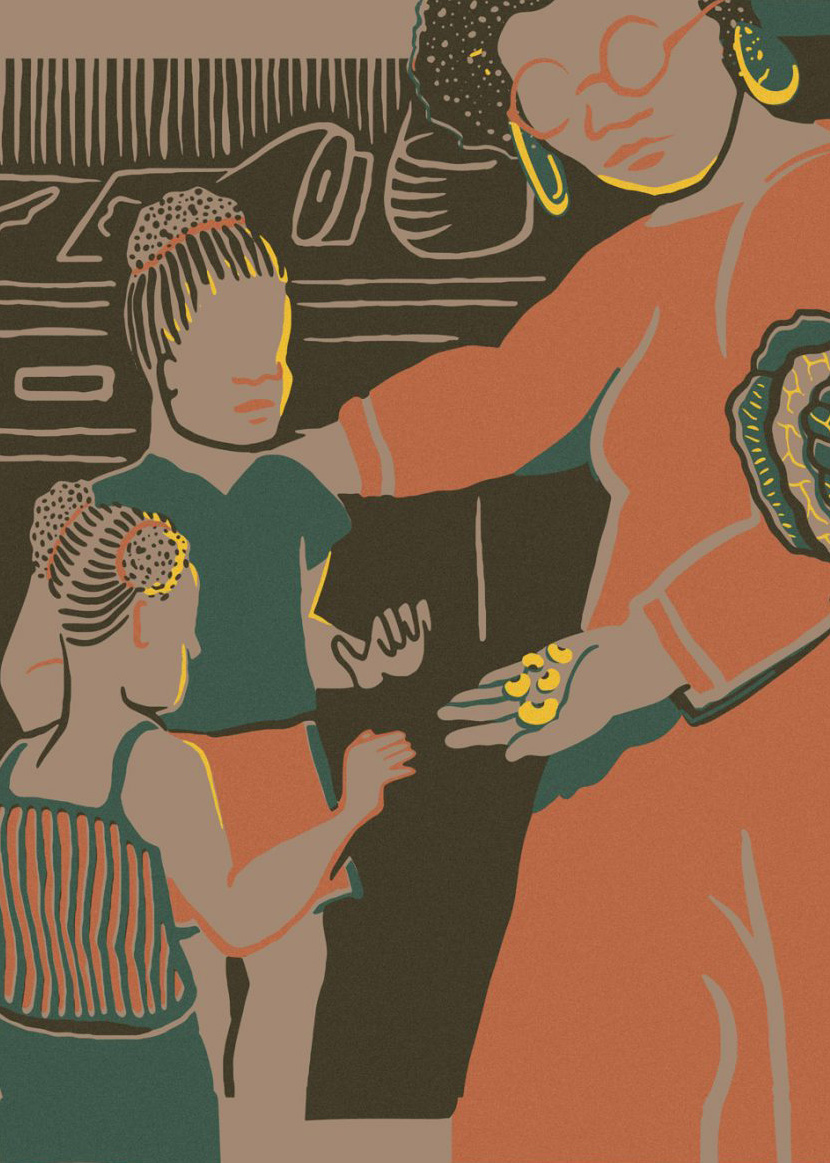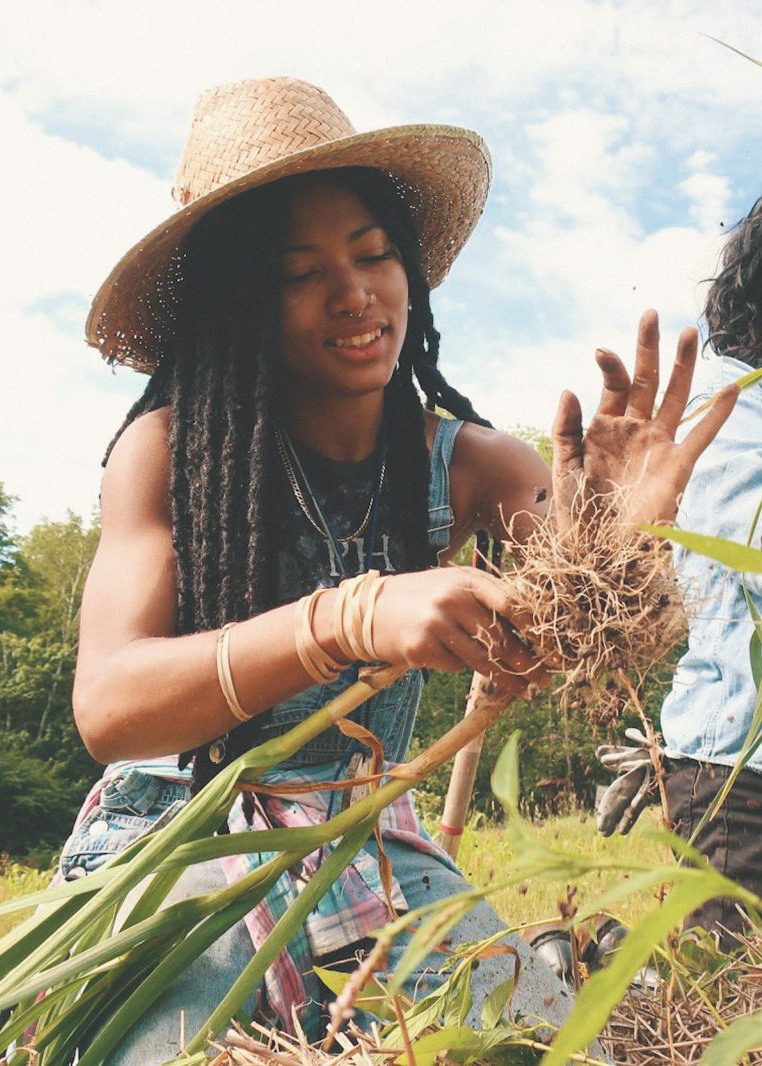
Emma Marris is a writer based in Klamath Falls, Oregon. Her stories have appeared in National Geographic, The New York Times, the Atlantic, Wired, Outside, High Country News and Nature. Her book Rambunctious Garden looks at how conservation is changing in the Anthropocene. Her forthcoming book Wild Souls will explore human relationships with wild animals in a changing world.
Jia Sung is an artist and educator based in Brooklyn. She is currently an art director at Guernica, teaching artist in residence at the Museum of Chinese in America, and teaching artist at the Children’s Museum of the Arts. She has exhibited work at the RISD Museum, the Whitney Houston Biennial, and La Mama Galleria. She is currently a 2018–2019 Smack Mellon Studio Artist and recipient of the Van Lier Fellowship.
From her own backyard compost pile in Oregon to the dark earths of the Amazon and Liberia, Emma Marris explores the possibility that there is more to our ancient kinship with soil than nutrient extraction.
The goddess Aruru, she washed her hands,
took a pinch of clay, threw it down in the wild.
In the wild she created Enkidu, the hero,
offspring of silence, knit strong by Ninurta.
—The Epic of Gilgamesh1
Invocation of the Muse
I walk out of my house, into my backyard, grab a stick, and dig at a patch of bare earth near my compost bin. I fill my hands, bring the soil to my nose, and inhale.
Much of what I smell is geosmin—from the Greek γεω- “earth” and ὀσμή “smell”—a compound produced by soil-dwelling microbes called actinobacteria. It is the smell of fresh, fluffy compost or well-tended garden soil, that musky, metallic, fresh-blood-and-old-leaves smell of beets and potatoes and root cellars—the smell of fertility, possibility. Humans are attuned to the smell; we can recognize it at concentrations below 10 parts per trillion. When rain falls on dry soil, it is kicked up into the air as a component of the electrifying scent known as petrichor, another Greek word, from petra (πέτρα), “stone,” and īchōr (ἰχώρ), the blood-sap that flows through gods’ veins. The smell has been shown to slow our brain waves, producing a calming, grounded feeling.
Fruit flies detect geosmin at high concentrations, using a single dedicated olfactory receptor called Or56a by scientists. They avoid it assiduously, because it is produced by molds on rotting fruit—molds that can be toxic to them. And that could be the reason we smell it so well too. A very strong geosmin scent can smell musty and moldy and deter us from eating food or drinking water that might make us very ill indeed. But a lower concentration could also signal the presence of water—since rain brings it out of soil as petrichor—or lush, fertile places. No one really knows.
Women react to the smell more strongly than men, on average. Women have a better sense of smell in general and are more attuned to odor, but it is hard to resist finding a deep, mythic meaning in our strong reaction to geosmin. In almost every culture, after all, Earth is female: Mother Earth, Gaia, Pachamama, Terra, Prithvi—goddesses who, like the soil, have the power to create new life.
So I breathe in my geosmin, a bit like the oracle at Delphi breathing in mysterious fumes from a crack in the earth before divining. I invoke a muse, choosing Polyhymnia, the muse of sacred poetry, as well as agriculture, born of Mnemosyne, goddess of memory and remembrance. Soil is the soul of agriculture, and although profane matters have often been disparaged as “earthly” by Christians, it is impossible for the mystery of earth to be properly described using an entirely secular approach. Soil is the womb and the tomb, the stuff of life and death, in which death is transformed into life. And if that isn’t sacred, I don’t know what is. Only Polyhymnia, with her serious eyes, will do.
So speak, O Muse, and tell us of our birth.
Body
In many creation stories, humans are made from soil. In the Mesopotamian epic of Atraḥasis, from the seventeenth century BCE, the god Aw-ilu was slaughtered and the goddess Nintu, “birth-giver,” mixed his body with clay soil to make humanity.
Nintu mixed clay with his flesh and blood.
That same god and man were thoroughly mixed in the clay.
For the rest of the time they would hear the drum.
From the flesh of the god the spirit remained.
It would make the living know its sign.2
In Genesis 2:7, God does something pretty similar.
Then the Lord God formed a man from the dust of the ground and breathed into his nostrils the breath of life, and the man became a living being.
The Egyptian god Khnum used Nile clay—and a potter’s wheel. Nüwa, the Chinese mother goddess, used mud to make people, because she was lonely and wanted company.
The parallels in these stories are not so very astonishing. After all, we are nourished by food and most of our food comes from the soil. The Maya believe that humans were created from maize, a link in the chain between soil and human life.
Pinch yourself. There between your fingers is a being made mostly of oxygen (65%), carbon (18.5%), and hydrogen (9.5%). Where did our bodies get these elements? Breathe in. There’s your oxygen. We get carbon from our food—from plants or animals that eat plants. Plants pluck carbon from the air with that amazing chemical reaction that many of us learned in school: photosynthesis. We mostly drink our hydrogen as water.
Soil is the womb and the tomb, the stuff of life and death, in which death is transformed into life.
But we are made of other ingredients too, heavier elements in lesser quantities, folded into our flesh like gold or rubies hidden in the earth. We are 3.2% nitrogen; 1.5% calcium; 1% phosphorus. The total list also includes smaller amounts of sulfur, chlorine, magnesium, potassium, sodium, iron, cobalt, and more. These elements generally come to us via plants, who find them in the soil. In a very real sense, we are partly made of soil.
When a woman is pregnant, soil-sourced nutrients pass through the umbilical cord to the baby. The baby’s blood turns red from the iron sourced from dark green leaves, in plants that plucked iron from the earth with questing roots. When my daughter was born and her little ruby fist closed around my finger, she used potassium to contract her finger muscles, potassium I passed on to her from sweet potatoes—unearthed and roasted—that had in turn absorbed the nutrient from the soil. We give our children these gifts of the dirt.
Life
Five-hundred-year-old Douglas firs hold up the sky in Willamette National Forest in Oregon, in an old-growth grove at the H. J. Andrews Experimental Forest. Children and mosquitos flit about, the children eat red huckleberries, the mosquitoes eat the children. As my children run, they bounce, almost as if they were in an inflatable castle.
I stoop down with my children to examine this bouncy soil. The top is almost a crust, criss-crossed with sap-sticky needles and fallen lichen. Underneath we find rich, dark-reddish earth, the color of a beautiful horse, that smells musty, spicy. This is the topsoil: minerals, air, water, invertebrates, and microbes—an effervescent layer of life and death, decay and rot, and a sizzling exchange of microscopic nutrients.
Thirty-six billion tonnes of topsoil is lost every year, mostly through erosion into waterways and eventually into the sea. A forest or old grassland is so thick with roots that even a hard rain cannot dislodge the soil. But remove the roots, and even a light rain or brisk breeze will send soil tumbling downhill in muddy rivulets or billow it up and away on the wind. Over-grazing creates a similar effect. If livestock eat all the vegetation, there’s simply nothing to hold the soil in place. Under the rich topsoil are layers with much less organic activity, dry mineral-based soils, quiet and inert, less good for life.
Given an increasing human population, very much reliant on food grown in fertile soil to survive, this topsoil loss is a global crisis. As people attempt to preserve soil and prevent erosion, they are incorporating older technologies, including windbreaks of trees on field edges, cover crops, reducing or eliminating tilling, creating terraces, and leaving crop residues on the field.
The topsoil is an ecosystem of its own, with predators and prey and complex food and communication webs. Here in the old-growth forest, roots crisscross the dark. Fungi drape their hyphae—long, elegant cells that fork like branches—across the roots and interpolate their bodies with the plant’s, becoming cross-kingdom collaborators, swapping food for nutrients, spreading intel and subterranean gossip. “There might be as many as 150 different kinds of mycorrhizae on the roots of a single Douglas-fir tree,” according to entomologist Andrew Moldenke of Oregon State University.
Near the surface of this forest, fallen fir needles are devoured by the millipede Harpaphe haydeniana. Its “fecal pellets” make a feast for the oribatid mite Odontodamaeus veriornatus. Its feces, in turn, will be food for bacteria and fungi. Meanwhile the ground beetles, Promecognathus laevissimus, hunt the millipedes, stalking and pouncing on them, then clamping down on their prey’s throats like tiny mountain lions. Every moment, life’s drama unfolds beneath our feet.
It is that life that creates the bounce. “Every time you take a step in a mature Oregon forest, your foot is being supported on the backs of 16,000 invertebrates held up by an average total of 120,000 legs,” Moldenke writes. The soil is its own universe.
Decay
If the topsoil is thus a thinly held world unto itself, it is also the substrate from which our world springs, the source of a huge majority of our food, the quick of the Earth, the sweet dark chaos from which gods make grass and grain and goats and men and women.
The mystery of working with soil is that the best way to make it more fertile—more life-giving—is to mix in dead things. Soil is the medium through which death becomes life. It is the liminal stuff that exists after death and rot but before sprouting life, growth, and nourishment.
If you compost at home, you may have become very accustomed to the amazing transformation of dead plants to humus; so I ask you to try to see it—and smell it—with fresh senses. Today: leaves, stems, specialized tissues, flowers, bright reds and greens and yellows, smells of carrots and lemon balm and cabbage and juniper, sharp thorns and downy lamb’s ears—so much particular and specific matter. Tomorrow: humus, uniform, black and fluffy, identically smelling, heady with geosmin. Magic. How does it happen?
Microbes mostly, according to Mary Tiedeman, a soil scientist at Florida International University. First, imagine a pile of banana peels. “You can think of a freshly dumped pile of peels as an ecosystem under transformation,” she says. “The first organisms that come to colonize are the larger species: mites and centipedes, beetles, insects, that are capable of chewing up large pieces of material. They defecate into the pile and start to break it down.” That waste becomes food for another suite of species, including fungi and bacteria, including the actinobacteria that produce geosmin. Bacteria are small but mighty, and their metabolism creates heat, which “ramps up the temperatures of the pile, which ends up killing the larger insects,” Tiedeman says. “As the compost ecosystem evolves, you have different temperatures, different pHs. It is like a feedback loop.”
“In an old-growth forest, the nutrient cycle in that system is a closed loop. Leaves fall off and microbes break them down and make those nutrients available again,” Tiedeman says. But when we grow plants to eat and harvest them, we take those nutrients away. If we want the soil to remain fertile, we must be able to replace them. Large-scale farmers add nutrients back one by one in synthetic or organic fertilizers. (Whether they will be available to plants depends in part on soil texture and how alive the soil is with invertebrates, microbes, and fungi.) At home, you can compost.
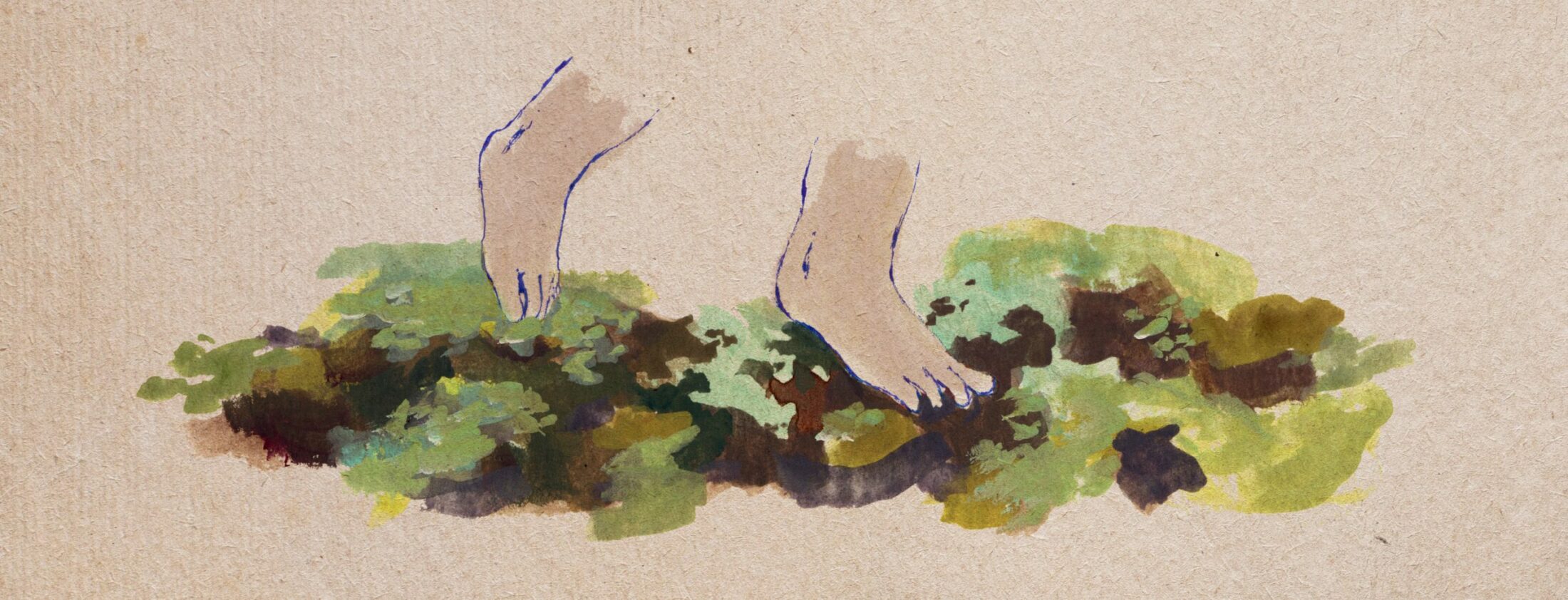
Memento Mori
Like most amateur composters, I mostly stick to plant waste. But a while back, through a complex sequence of events involving a ranch south of Crater Lake, a wolf biologist, a small hatchet, and an IKEA bag, I came into possession of a very large steer head. (To be clear, the steer was long dead before I acquired its head.) I wanted to mount the skull and horns but needed to remove the flesh and hair. So I buried the head under my compost pile. To ward off rodents, who might gnaw the bones, I first wrapped it in wire mesh. And then I left it there for eighteen months.
Most living things, by weight, are plants. There are about 450 gigatons of carbon in the plants on Earth and just 2 gigatons in the animals. Nevertheless, we are animals, so we are particularly interested in their post-mortem fate. When most animals die, their bodies withdraw from one set of roles in one food web and take up new roles in a completely new one. A predator becomes a nursery for fly larvae; a herbivore becomes a sack of bones of contention between a family of coyotes and a pair of ravens. Mammal and bird scavengers, beetles and flies and worms, microbes and yeasts, all come to the table.
Rot is not a pretty thing, at least not to us. The carrion beetle, on the other hand, sees in an oozing corpse the cozy security of a Christmas feast. We like the smell of soil, but not of rotting animals. That sweet spicy reek of unknitting flesh repels like few others. We are disgusted but also afraid. What if the killer is still nearby? Better to come back later, when the rotting is nearly done.
It might take awhile, but the dead animal will usually fully return to the soil. Taphonomy is the science of bone rot. (It is also the study of how bones become fossils, thereafter useful to us as messages from a long-ago world. This happens only rarely, when the bones are thrust into an environment without oxygen, where the unfolding ecosystems of decay cannot thrive.) The vast majority of bones are eaten—cracked for the marrow and then gnawed to nothing for the calcium—or simply sucked dry of grease and oil, bleached in the sun, cracked in the cold, and weathered into powder, the calcium returning to the earth. To dust we return.
At first, that corner of the garden smelled like death, and my children complained. But time, invertebrates, and microbes performed their magic. One early spring day, I disinterred the head before the bones could fully disintegrate. The eyes were long gone, the flesh, magically transformed. The empty orbits were packed with rich black humus.
Until recently in the United States, it was illegal to compost a human being after death. That changed, at least in Washington State, in 2019. A company called Recompose hopes to be the first provider of post-mortem “natural organic reduction,” while offering “a place where we can reconnect with the cycles of nature and treat bodies with gentleness and respect,” as founder Katrina Spade says. Laid in an elegant hexagonal container, cradled in a carefully balanced ratio of wood chips, straw, and alfalfa, and periodically turned, a human body will decompose quickly. After a month, the body and its accompanying vegetation are transformed into a cubic yard of soil, ready to be given to loved ones to scatter in a beloved forest, or to grow roses or a tree. “Our bodies when we die are full of potential,” Spade says. “We still have something to give back.”
Fertility
We are accustomed to hearing stories about how humans are hurting other species, destroying nature. Narratives of good, productive relationships between the human and nonhuman are rarer and can be startling. But the world and history are full of them, and our relationship with soil is no exception. Humans have been working to improve soil for millennia, mostly through the everyday practices of making and adding compost. Exact methods have varied but often include mixing animal manures, ashes, bones, and plant refuse directly into soil that will later be planted with crops. Farmers have long applied livestock manure to fields. In ancient Summerian cities, urbanites pooled their refuse at municipal composting facilities for transport to the fields outside town.
In some cases, ancient relationships with the land created soils so distinctive, so alive, that they persist into modern times as deep, dark deposits still far more fertile than the untended dirt in the same area. We can literally run our fingers through rich loam made by people hundreds of years ago.
In Europe, “plaggen” soils were maintained for up to 3,000 years, spread with manure, livestock bedding, and peat, until they became intensely fertile and rich. In Brünkendorf in Northern Germany, a tenth-century Slavic settlement was unearthed that featured dark black soil. Chemical analysis showed it had been enriched with charred material, as well as manure from humans and other animals. The researchers who described it propose that such soils may have been created intentionally and helped support the economy of the pre-Christian Viking–Slavic world. Dark soils from prehistory have also been found across Australia and Africa.
The most famous of these ancient soils is undoubtedly the terra preta—dark earth—of Amazonia. Much of the soil in the Amazon rainforest is very nutrient poor, a thin red dust. However, there are key spots, often along rivers, where one can find deep, dark black soil—cluttered with potsherds and extraordinarily fertile—rich with calcium, phosphorus, and potassium. This soil seems to even be able to renew its own fertility over time. Crops have been grown continuously in terra preta for four decades without supplemental fertilization—and they remain fertile for hundreds of years.
Researchers hypothesize that Amazonians started incorporating charred organic material, manure, and bone into the soil more than 5,000 years ago. Small areas were cleared with low-intensity fire, and then the charred plant matter remained to fertilize the soil. Likely, household refuse was also incorporated. The charred organic matter within the soil creates better conditions for nutrient movement and increases the growth of fungi and bacteria. Terra preta has 25% higher species richness than surrounding soils, in part, experts think, because the particles of char create hiding places for microbes where they can escape being eaten by predatory mites and nematodes. These deposits are currently highly prized, and some very successful farms are situated on top of them.
Ancient relationships with the land created soils so distinctive, so alive, that they persist into modern times.
The extent and spread of terra preta has helped show that the Amazon is not a pristine wilderness that was only ever home to a few scattered peoples. Before Columbus, it was home to a large, settled, agricultural population, especially along its great rivers. And these people didn’t just “live in” the rainforest, creaming off the rich resources it provided. Terra preta shows that they fundamentally changed their home, collaborating with the nonhuman world to create complex new ecologies that included them. Today, the “wild” rainforest is dominated by more than eighty plant species—including Brazil nut, abiu fruit, and cacao—that were domesticated by pre-colonization Amazonian peoples; it is essentially an overgrown food forest.
Little new terra preta is being created in Amazonia today. The practices and lifeways that helped create the soil were massively disrupted by colonization. First disease came with European invaders and missionaries in the 1500s, followed by hundreds of years of murder and enslavement by those seeking gold, timber, rubber, or souls for God. In the pain and confusion, villages and whole peoples fled in the night, moved to new river valleys, lost generations of memories. With few exceptions, the link between specific people and specific soils was broken.
One place where new dark earth is still being created is a Kuikuro community in the Upper Xingu region of southeastern Amazonia. Researcher Morgan Schmidt spent time in the village and documented how community members travel up to ten kilometers to farm in ancient terra preta sites, and how they boost the fertility of soil closer to home. Outputs from feeding the village become inputs to the soil. “Organic refuse is not seen as ‘garbage’ by the Kuikuro,” he writes. “Instead, it is a valuable resource that contributes to agricultural productivity.”
In Liberia and Sierra Leone, some villages are also still making dark earths in the same way their ancestors did. James Fraser, a transdisciplinary anthropologist now of Lancaster University in the UK, spent much of 2011 in West Africa with his wife, Victoria Frausin, studying how villagers make the soil. “Basically, dark earths form around sites of food processing where you have burning and also palm oil processing,” Fraser says. Wherever there are kitchens, there are disposal sites, and over time, the bones, charred organic matter, and other waste slowly become part of the soil.
One female elder from the village of Wenwuta in Liberia, Kortor Flomo, explained, “What makes the soil so rich? The dirt we put there and burn over and over for a very long time will change the soil. The black soil is rich around the town because the things we throw there: rice straw, fire ash, other materials. Soils on the farm are not as rich as those around the town, as they do not have things thrown on it like in the town…. The soil that god made, it never had pepper, bitter ball, okra, plantain, on it. But it was us that had that idea of planting things in the soil, and throwing things on the soil making the soil rich, it was not god.”
When I was interviewing Fraser about these soil creators, I kept getting hung up on the same question: whether or not the soils were made intentionally. The villagers clearly knew how they come about, but did they make them on purpose to make fertile soil to grow crops? Fraser says he gets this question a lot. And he tried to explain to me that the question itself comes out of a very Western, capitalistic mindset.
I assumed that if people could understand how fertile soils arose from their actions, they would immediately set to work trying to reproduce and enlarge the effect, making more and more fertile soil, producing more and more crops. But perhaps more wasn’t a major focus for them. “Traditionally people were concerned with reproducing their communities rather than maximizing individual profit,” Fraser says.
The villagers do not so much set out to make the soil as it organically emerges from their mode of life. The villagers understand this process and see their role in improving the soil as a kind of positive adjunct to natural processes. As women often told Fraser and his wife, “It was god who made the soil, but we put the dirt there and made it fertile.”
Fraser and his wife pointed out in their article about the African dark earths that it is primarily women who make these soils. Perhaps Mother Earth can herself have many mothers.

Mother Earth
When I compost at home, it is a highly intentional act. It doesn’t just emerge from my daily life. I have to go out of my way to sort my waste and divert the organic matter to a seperate little container on my counter. It takes a conscious act of will to break out of the dominant social structure, which sees humans placed in the center, scooping up things from “nature,” making them into technologies and goods to feed our ravenous appetite for comfort, beauty, and status, then tossing our refuse into huge ecologically inert holes in the ground. The strength of the Liberian village society Fraser studied is that their default lifeways create more life, and are ecologically integrated with the species around them. As he put it, “For them it is a way of life. Compost is a kind of hobby.”
Schmidt wrote something very similar about the Kuikuro. “In a sense, ‘intentionality’ and ‘unintentionality’ in the formation or ‘production’ of enriched soils and terra preta cannot be easily separated.”
Despite years of trying to extricate myself, I’m still trapped in the Western nature/culture dichotomy. In this framework, where humans are distinct from nature, the moment a human touches anything with intentionality, it ceases to be nature and becomes “technology.” And it follows then that anthropogenic soils wouldn’t be nature: they would be technology. But technologies are usually less alive than the “natural resources” they are fashioned from, whereas the dark earths that humans help make around the world are more alive than soils nearby.
These beautiful, fertile soils are not so much technological products of human intention as they are ecological niches that human activity creates for other species to thrive. Humans consciously participate in their co-creation, and the result is still “nature” and also a useful space to support human flourishing. But the humans involved don’t write “make dark soil” on their to-do lists. They don’t have to.
Fraser has moved away from studying dark earths made by humans in part because he saw how quickly knowledge about their creation was being commodified and sold as a “fix” for an unsustainable agricultural system. “It just isn’t going to work if we are making dark earths in a capitalistic society,” he says. “It is about all the system around them, it is not just about the soil. We can’t take out this practice and reproduce it and this will lead to sustainability.”
Indeed, terra preta nova—newly made soil enriched with charred plant matter—has been touted not only as a way to grow more crops on a smaller land base, but also as a carbon sequestration technique to fight climate change. When organic material is partially burned and the charred remains are incorporated with the soil, the result is not just better soil, it is also the internment of a significant amount of carbon that would otherwise have gone up into the atmosphere as smoke.
It is an intriguing idea. In places where burning makes sense and there is plenty of organic waste matter lying about, it could be a helpful tool. But Fraser and others worry about it becoming a faddish panacea with the added brand-boost of its connection with Indigenous people. Erich Pabst, a retired researcher now living in small-town Amazonia, shares Fraser’s concerns. He says that commercially produced biochar currently for sale in his home country of Germany just doesn’t have the same magic as old terra preta. “All my experience in my contacts is that nobody at the moment is able to make terra preta,” he says. He has his own pet theory: “I personally believe that [they] had a kind of catalyst that triggered the soil organisms to be more busy and to transform the topsoil,” he says. The mystery remains.
The transformation of death into life in the soil is one of the many nested rounds that turn and turn within Mother Earth, just as the globe turns around the sun: the hydrological cycle, nutrient cycles, seasons, biological life cycles, seventeen-year cicadas, mast years, migrations, and annual feasts. But never forget that her cycles are not unchanging. Evolution, plate tectonics, geologic-scale climate change, and other grand forces mean that every turn of the wheel is slightly different than the last. It is a mistake to think that a cyclical view is an unchanging view.
My life and death will, in many respects, mirror my mother’s and her mother’s and hers. I was born, took tottering steps, and eventually had my own daughter—but my life is my own unique journey, just as my daughter’s will be hers alone. For now, I have some influence. Taking out the compost is my children’s job; they do not know I am secretly ensuring that they take regular deep breaths of geosmin.
Once we dissolve back into the soil, we can nurture new life, start a new cycle. Out of rot and bones and death comes rich loam full of potential, and out of such sweet earth comes tomatoes and apples, mint, and grain, and pasture for animals.
Nearly every mouthful that passes our lips, from the snap of a summer pea to the soft comfort of a roasted winter beet, represents but a moment of specific order and pleasure in a cycle thousands of years old, a round of death and soil and birth and food and being and dying and rotting and soil. As we eat, let us remember.
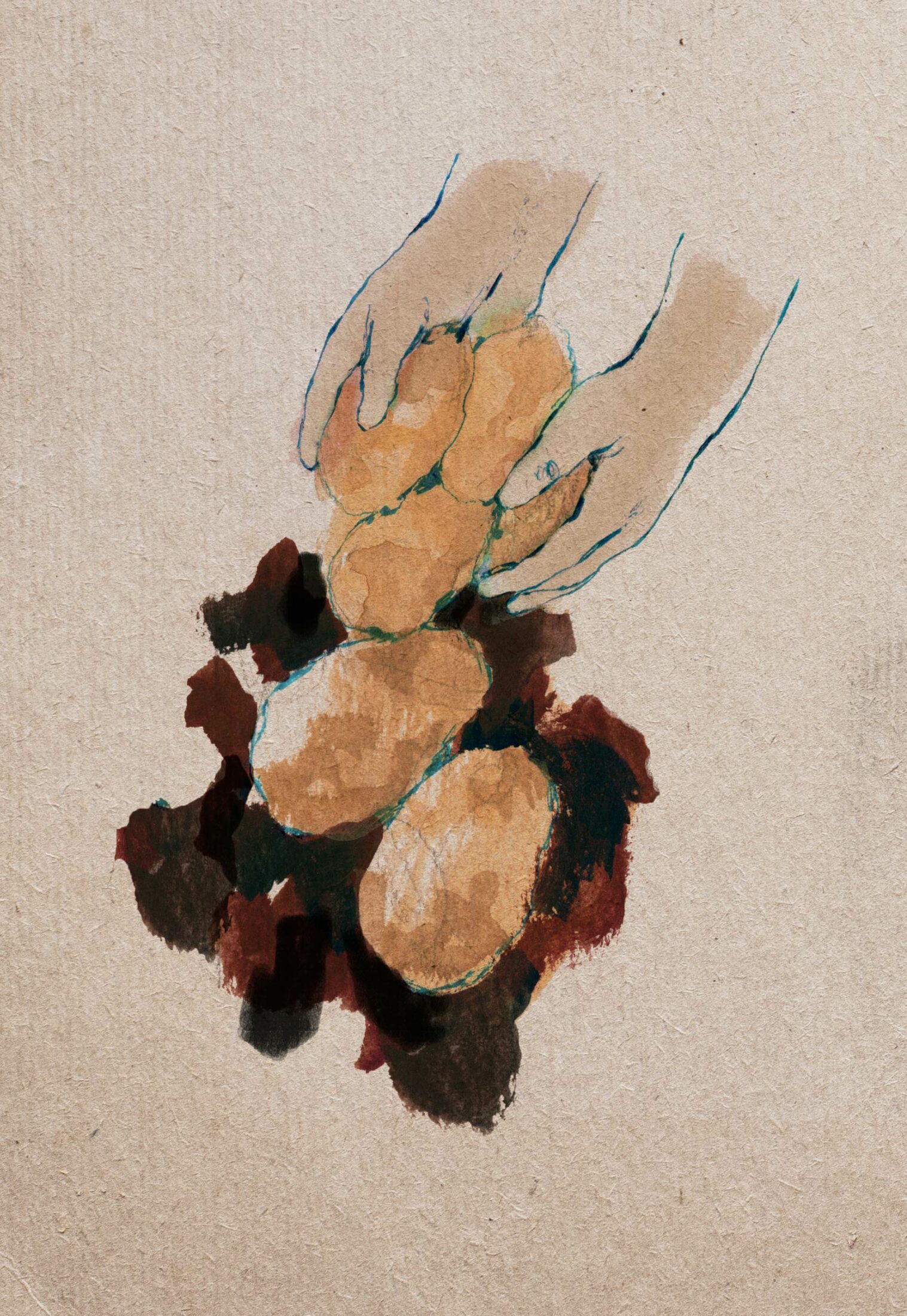
- The Epic of Gilgamesh: A New Translation, trans. Andrew R. George (London: Penguin, 2000), “He Who Saw the Deep,” Tablet I, lines 101–104. Compiled from 73 Babylonian manuscripts dating from the first millennium BC, this standard version of the epic was known in Babylonia and Assyria.
- “The Epic of Atraḥasis,” Livius, last modified by Jona Lendering 6 May 2019, https://www.livius.org/sources/content/anet/104-106-the-epic-of-atrahasis.
